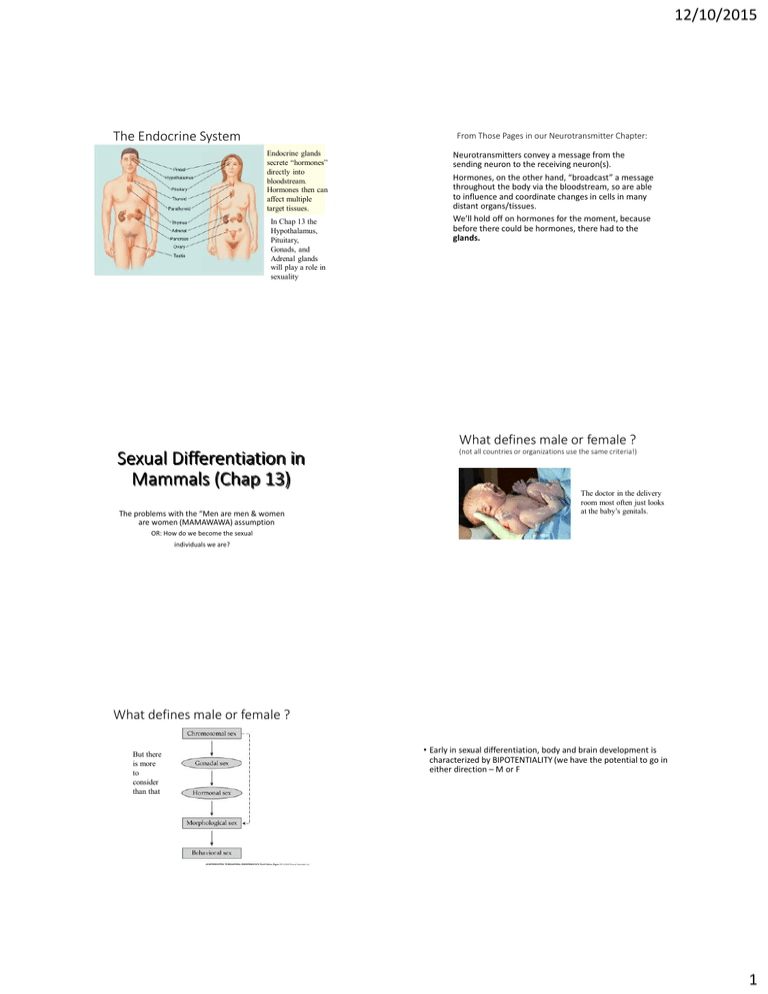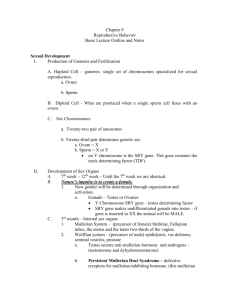12/10/2015 The Endocrine System
advertisement

12/10/2015 The Endocrine System From Those Pages in our Neurotransmitter Chapter: Endocrine glands secrete “hormones” directly into bloodstream. Hormones then can affect multiple target tissues. In Chap 13 the Hypothalamus, Pituitary, Gonads, and Adrenal glands will play a role in sexuality Neurotransmitters convey a message from the sending neuron to the receiving neuron(s). Hormones, on the other hand, “broadcast” a message throughout the body via the bloodstream, so are able to influence and coordinate changes in cells in many distant organs/tissues. We’ll hold off on hormones for the moment, because before there could be hormones, there had to the glands. What defines male or female ? Sexual Differentiation in Mammals (Chap 13) The problems with the “Men are men & women are women (MAMAWAWA) assumption (not all countries or organizations use the same criteria!) The doctor in the delivery room most often just looks at the baby’s genitals. OR: How do we become the sexual individuals we are? What defines male or female ? But there is more to consider than that • Early in sexual differentiation, body and brain development is characterized by BIPOTENTIALITY (we have the potential to go in either direction – M or F 1 12/10/2015 Role of Sex Chromosomes Differentiation • Genetic sex (XX or XY) is determined by the sperm (X-bearing or Y-bearing) that fertilizes the egg. • Early (“primordial”) gonads have potential to be either ovaries or testes for first 6 weeks of gestation. • “Sex-determining region of the Y chromosome” (SRY) is a gene producing a *protein causing the middle of baby gonads to become testes. • If testes develop, they begin to produce androgens like testosterone. • If SRY gene is not present, the outside of the early gonads turns into ovaries. *SRY protein sometimes called testis-determining factor Experimental Evidence • Removal of SRY gene from Y XY mouse develops female gonads • Add SRY gene to X XX mouse develops male gonads • Injection of SRY’s protein in genetic female develops testes • Inject genetic male with drug that blocks the SRY’s protein develops ovaries Figure 13.6 Organizational Effects Endocrine Glands – Release hormones directly into bloodstream Although the pituitary is sometimes called the “master gland” in fact the hypothalamus is the “master” of the pituitary. • After gonad development, most of the remainder of sexual development depends largely on hormone environment during early critical or “sensitive” period. • Normal sources of sex hormones: • *Testes and ovaries • But adrenal cortex can also produce sex hormones too 2 12/10/2015 Bipotential Early Ducts, Genitals & Brains • We all begin with ducts, genitals & brains which can go either way (male or female) • The “default” setting for development of the reproductive system is “female”. Most steps will occur in the absence of hormones. (Female differentiation of some brain areas IS, however, affected by early estrogens) • Prenatal differentiation of male ducts, genitals, & brain depends on action of androgens (testosterone & dihydrotestosterone (DHT)). Figure 13.7 We all start out with the same nubbin of a genital • In fact, in males, development of female ducts must be actively inhibited by release of another hormone from testes: Mullerian inhibiting hormone (MIH), usually in 3rd month of gestation for humans. • If this hormone is absent, males will have both male and female duct systems inside. • Are androgens present? Then left path is followed. • No androgens? Then right hand path is followed • Full masculinization of genitalia occurs primarily in response to dihydrotestosterone (DHT) Figure 13.8 Sex Differences in the Brain • Do male and female animals show different sex-typical behaviors because of genetic makeup or because of hormone exposure? • Pfeiffer (1936) gonadectomized and implanted gonads in neonatal rats: • Pfeiffer first discovered a sex difference in mammalian brain function • Transplant of testes to males or females causes steady (male) gonadotropin release pattern • Perinatal androgens lead to male pattern • Gonadectomy causes cyclic (female) gonadotropin release pattern 3 12/10/2015 Differentiation of the Brain • Androgens also have masculinizing effects on developing brain. • Example: Exposure to androgens “program” the hypothalamus for the fairly constant sex hormone secretions seen in males vs the cyclic hormone secretion of females. Exposure to androgens leads to growth of certain brain areas; their absence develops other regions. • Masculinization of brain appears to occur later in gestation than masculinization of body. • Early estrogens have some feminizing effects on the brain • Early hormone environment also leads to corresponding behavioral changes. Sexually Dimorphic Nucleus (SDN) of Preoptic Region of Hypothalamus Sex-Typical Behaviors Early exposure to androgen mounting & thrusting later in life Or castrated male No early androgens lordosis (female sexual posture) later in life Another of Mother Nature’s Jokes: The Aromatization Theory • Masculinizing of the rat brain is not just due to testosterone • Testosterone entering rat brain is turned into estradiol! • Estradiol, in turn, triggers “masculinization” of the brain. • Brain areas like the hypothalamus which show sex differences have high levels of aromatase enzyme that converts TE during the sensitive period. • If this enzyme is blocked then T does not masculinize brain! • Maternal estrogens bind to alpha-fetoprotein & can’t leave the bloodstream so don’t masculinize brain. • However, if excess synthetic estrogens are present, some do get into brain and can bias brain/behavior in a male direction in a variety of species including humans. • * Now know this is not the only mechanism causing sex diffs in brain & that this does not seem to be the primary influence in humans, but unusual exposure to estrogens may have some impact. Hypothalamus secretes “gonadotropin releasing hormone” to tell pituitary what to do In response, anterior pituitary secretes “gonadotropins” to tell the gonads what to do Without these hormonal commands, gonads won’t produce sex hormones or sperm/eggs 4 12/10/2015 Summary • Early in life hormones have an organizational effect on body and brain. • Amount & timing of hormones will have a life-long effect on physiology & behavior. • Alterations in hormones during critical periods of prenatal development are a likely causes of variations in sexual orientation & gender dissatisfactions. • In utero biasing of brain may be more important to gender identity than sexual differentiation of the body. • Later in life, hormones serve to activate sexual motivation & the functioning of those organs (e.g. menstrual cycle, make sperm & eggs ) • Notice the feedback loop on right. • Hypothalamus monitors hormone levels in blood to decide whether further commands to pituitary are needed. Organizational vs Activational Effects Of Sex Hormones • Organizational Activational • permanent effects - transitory effects • occur mostly during early critical period - in pubertyadulthood • structural changes in body & brain - motivational & functional changes Other examples of brain differences • Females • More neurons in the planum temporale • Larger corpus callosum • More programmed cell death (apoptosis) during development • Males • Larger cortex • Thicker right hemisphere cortex • Different cellular organization in several regions of cortex • Activating effects of hormones increase sensitivity to sexual stimuli and increase the activity of sex regions of the hypothalamus. • Sexual receptivity of females of many species is totally tied to their estrogen levels (primates seem less dependent on estrogens) • Castration decreases sexual motivation and activity, but doesn’t necessarily abolish sexual behavior in those with sexual experience. • Studies of women not on hormonal birth control show a peak of sexual interest just before ovulation. Sexual Orientation • ↓ mid-pregnancy testosterone in males OR testosterone treatment of females induces same sex preferences and changes in other sex-typical patterns of behavior in a wide range in species (rats, hamsters, ferrets, pigs, finches, dogs, sheep etc.). • Data from both men and women shows a correlation between early hormone environment and later sexual orientation. • Maternal stress & some drug used during pregnancy can decrease testosterone exposure; other drugs may act like androgens (e.g. diethylstilbestrol (DES)) The fact that there are brain differences should make us expect to see some behavior or ability differences. 5 12/10/2015 Other Evidence for a Biological Basis of Sex Orientation 60 Minutes segments • Brothers both homosexual? • • • • identical twins - 52% fraternal twins - 22% Non-twin brothers – 9.2% adopted brothers - 11% • Sisters both lesbian? • • • • Identical twins - 48% fraternal twins - 16% nontwin sister – 14% adopted sisters - 6% • http://www.youtube.com/watch?v=d5vrNYA_nik • http://www.youtube.com/watch?v=-S5QYVe0mJY&feature=channel • National Geographic • http://www.youtube.com/watch?v=saO_RFWWVVA&feature=related • Pattern of results replicated in small representative sample from national twin study • The more older brothers a male has, the greater the probability that he will be homosexual. • Hypothesis – mother’s earlier pregnancies carrying a male fetus triggered future immune responses against testosterone or some related protein. Sexual Orientation Brain Differences • Simon LeVay- 3rd interstitial nucleus of the anterior hypothalamus (INAH3) in humans is larger in heterosexual males and smaller in females and gay males. • Other areas of brain that differ with sexual orientation: • • • • Anterior commissure Suprachiasmatic nucleus Both are larger in heterosexual women and gay men These are not areas known to be related to sexual behavior, but the pattern does suggest the brains of gay men are more similar to female brains than heterosexual male brains. • So is the androgen environment not just “masculinizing” body and brain, but actually influencing factors like motor programs for how one moves, vocal tone and inflection, and interests/preferences? • There is also a growing body of research looking at early hormone environment, brain differences and genetic contributions related to transgender cases. Case 1 • Baby Maggie – normal female appearance, but: • • • • • No Mullerian ducts No Wolffian ducts High levels of androgens in blood XY chromosomes Gene mutation on X in region of androgen receptor gene 6 12/10/2015 Androgen Insensitivity Syndrome • X-linked recessive defective variant of the androgen receptor gene • Androgen ineffective small testes, no male ducts, female genitalia but no female ducts. Have female identity • (supports a role for androgen receptors in some aspects of masculinization of human brain) • At puberty don’t see pubic hair or darkening of nipples (normal androgen effects in females) • If AIS is known to exist in a family, genetic testing can reveal whether a woman carries the recessive gene • 1 in ~13,000 births have complete androgen insensitivity; in addition some are born with partial insensitivity (probably another mutation) Case 2 • Baby Chris • • • • • • Empty scrotum Much smaller penis than previous 4 sons No undescended testicles Enlarged adrenal glands Well developed Mullerian ducts & ovaries Abnormally low levels of cortisol & high levels of androstendione Hyp Congenital Adrenal Hyperplasia or Adrenogenital Syndrome One cause of androgen exposure in females • The effects of androgen exposure of a female fetus • Degree of masculinization depends on amount of androgen and timing • Also about 1 in 13,000 births • In CAH, genetically based deficiency in the enzyme (21 hydroxylase) needed to produce cortisol leads to excess adrenal androgen production. No cortisol feedback leads to continued hypothalamic stimulation of production. CAH is associated with • Greater preference for boy toys and later for sports magazines, masculine sports, even male dominated professions like auto mechanic, truck driver • Increased physical activity; increased aggression • Low romantic interest in males at adolescence; less interest in infants • Moderate increase in bisexuality or homosexuality, or continued low interest in sexual relationships • Usually score intermediate between females and males and degree is correlated with androgen level 7 12/10/2015 Case 3 • Baby Santino: • • • • • XY chromosomes Normal levels of testosterone but no DHT Deficiency of 5-alpha-reductase Wolffian ducts, undescended testes Female genitalia with what looks like an enlarged clitoris Case 4 • Baby J: • Normal male baby boy • Penis accidentally burnt off during circumcision • Parents advised that male genital could not be reconstructed, but could be fashioned into female vulva/lower vagina. • Parents advised to totally & consistently raise baby as a female 5-alpha-reductase deficiency “Guevedoces” (“eggs@12”) Testosterone can’t be converted to dihydrotestosterone which is most important androgen for masculinizing genitals before birth. Testosterone surge at puberty does stimulate growth of penis and scrotum. Most easily transition to male gender identity despite early upbringing Role of Environment? • The Case of John/Joan – unsuccessful rearing as female after penis was burned off • http://www.youtube.com/watch?v=QeSvkE9ZtHk • DHT deficiency – despite years as a female, easy switch to male identity at puberty. • In these cases brain would be masculinized by early testosterone. • Those who pursue sex changes after years of upbringing as a particular gender may also be responding to the particular differentiation of their brain. Activational Effects • In adulthood hormones activate sex motivation and reproductive function. 8






